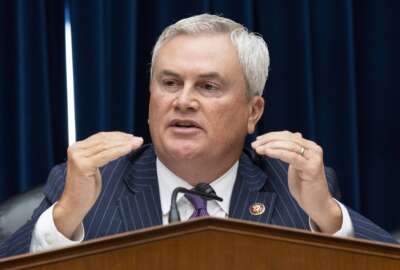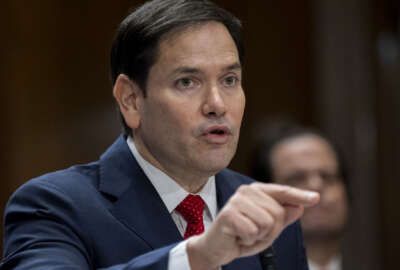Commerce Department spreads Chips Act money across the country
"The Recompete program is a program that's designed to invest grant funding into economically distressed communities across the country," said Rachael Sun.
The Commerce Department’s Economic Development Administration has made 184 million dollars in grants to six local jurisdictions. They’ll carry out plans to improve local economies. With how and why these six communities were chosen, the acting director of the Recompete Pilot Program, Rachael Sun joined the Federal Drive with Tom Temin.
Interview transcript:
Tom Temin And just give us the brief background on the Recompete Pilot Program. These are recompeting for pilots to do what?
Rachael Sun So the Recompete program at its core is a program that’s designed to invest grant funding into economically distressed communities across the country. Really, the goal here is to tackle this distress with a focus on jobs. So of the six awardees we were very excited to announce last month, really, And most of them focus on one of two things. So either a strategy to create jobs in communities that either no longer have them or have been historically underinvested in, or to perhaps invest in communities where there are access to good jobs. But certain parts of the community have been left out of the access. So in those communities, it might be certain barriers that leave people out of the economy, whether that’s workforce training, access to wraparound services, things like that. But really, at its core, this program is a jobs program with a focus on places that have been historically left behind across the country.
Tom Temin And the release describes this as finalists, these six areas as finalists. So there was a first round in which many more communities got sort of seed funding.
Rachael Sun Yep. Great question. So maybe just going backwards about a year. I can give a bit of context on the program origin and how we got to this point. But the recompete program was authorized as part of the 2022 Chips and Science Act. So we received authorization for appropriations up to $1 billion. We were very lucky to receive $200 million in appropriations in fiscal 2023 to really pilot the first round of the competition. And so backtracking about a year, we launched the notice of funding opportunity as a two phase competition to your question. So in the first phase, really, we asked applicants to come to us and say, Hey, at the highest level, what is the concept for your plan to address economic distress for your community? In that phase, we received 565 applications. So this was the highest subscribed competition we’ve ever run at the Economic Development Administration. Really speaking to the level of demand across the country. That 565 at the end of phase 1 became 22. So we selected 22 finalists. President Biden announced them in December of last year. And those 22 finalists really represented the top 10% of the country in terms of plans that we really believed in, that we thought this is a real strategy to address economic distress, really improve employment in these communities that have been so left behind. So that was phase one to phase two. And then phase two or to announcement, which is what you just referenced. So the 22 became six. We were able to award those six anywhere from $20 million to $40 million each in grant funding to really then move forward and implement the strategies that they had proposed. And then in parallel, we also awarded over the past year about 24 strategy development grants. So those grants are about half $1 million each, really intended to help teams continue to refine their strategies as we know this stuff takes time, and we really want to see the work go forward.
Tom Temin And you mentioned the money originally came from the Chips and Science Act. Are these grants, do they have anything to do with semiconductor production or manufacturing in any way what the strategies are?
Rachael Sun Great question. So it was authorized through the Chips and Science Act, but the specific activities of focus for recompete are as related to direct some conductor investments. Really, the activities that we’re funding are within the spectrum of what EDA would generally fund, and we’re quite flexible on that. So we’re funding anything from workforce training programs to small business supports to building infrastructure to coordination and governance dollars within these communities. But I do want to take a step back and put it in context of why it was authorized through chips. So while we could be as a program focused on distressed communities, we know broadly that here at the EDA, our mission is to prepare American regions for competitiveness on the global stage and to be really competitive and secure in this global economy. And so we can get to role within that as we know that it’s impossible to do this while we know that many parts of the country continue to be left behind. And so through programs like recompete, we can bring those left behind communities and really invest in them so that they can achieve economies that work for both their local residents but also thrive within the global economy.
Tom Temin We are speaking with Rachael Sun. She’s acting director of the Recompete Pilot Program, part of the Commerce Department’s Economic Development Administration. And just two of the areas that I know a little bit about Allentown, Pennsylvania, and Birmingham, Alabama. Those are places that used to be wealthy in the metalworking and metal processing, steel and so on, which has mostly fled almost all of the United States. Just describe for us briefly those two areas. What did they do and what will they be doing with this grant money?
Rachael Sun Yeah, totally. Thanks for bringing this up, Tom. So on Allentown exactly speaking to what you just mentioned, what we’re seeing in the Allentown community and more broadly within the Lehigh Valley region is a resurgence in manufacturing. So as you said, historically, steel focus, historically industrial. Now seeing actually growth in manufacturing sectors above the national average. And so that’s kind of what the team said to us. Hey, we’re seeing all this regional growth, but there are three specific neighborhoods within the city of Allentown that have not really been seeing the benefits of this growth. And so we see residents there, about 70% of the community there is Hispanic or Latino, where we actually do see really high unemployment. And so we see poverty rates at about 34% in those communities. We see that the number of working age adults in those communities significantly lags the national average rate. And so they said, Hey, we’re really going to take this opportunity to zone in and take a highly targeted approach, and propose a plan that really gets residents in this communities to those good jobs that are in the surrounding region.
Rachael Sun So to speak a bit more to that. We just awarded them $20 million to implement a series of eight different projects. Those projects fall into a couple of categories. So they have a workforce development training program that’s intended to reach those residents. They have some work focused on child care. We know across the board that child care continues to be a barrier for residents to access good jobs and even participate in training. So part of the funding will be to bridge those gaps and also to increase the supply of child care in that community. Another bucket of funding for them will go towards improving transportation access. So how are you expected to continue to retain a job or retain training without affordable, easy transportation to those locations? And then the last piece is focused on continuing to invest in local manufacturing, continue to invest in the infrastructure needed to bring small businesses and jobs into the community. And so we’re really excited about this program, because as you can tell we have a pretty broad funding remit to give flexible funding towards communities in a locally driven way. And that’s what we’re seeing happening in Allentown and excited to kick off that grant over the next few months.
Tom Temin And by the way, what do they make now in the Lehigh Valley? Do we have any sense of what’s driving that manufacturing resurgence?
Rachael Sun It’s a great question. So I think there’s a lot of tradition in the Lehigh Valley, and especially we were just in Allentown last Monday doing high customization, low volume manufacturing. So the strategy really isn’t to choose a specific sector per se, but you have all of these manufacturing business owners who are able to say, Hey, we can take you end to end on a product development and really be able to customize this product. So it really varies across the spectrum. Anything from water sanitation products to thinking about industrial manufacturing to other sectors. But really the specialty is being able to customize to the degree possible.
Tom Temin So it’s not motors for electric cars, for example, quite yet.
Rachael Sun Multiple sectors, but yes, focusing on quite a few.
Tom Temin And what about Birmingham?
Rachael Sun Yeah, totally. So in Birmingham, this is also one of our places where you see that the strategy is there are actually quite a lot of good jobs. But again, people really can’t get to those jobs. So they’re focused on four neighborhoods on the northwestern side of Birmingham, and these are four neighborhoods that have been historically redlined predominantly black, have seen the effects of multiple decades of disinvestment. And so really in Birmingham, there’s a focus here on employer commitments that we saw above and beyond in the competition. This team was able to bring in employer commitments of nearly 4,000 plus jobs, where over the course of the year that they participated in this competition, the team went around to the Coca-Cola Bottling Company. They went around to the local pipe fitting company, to the local Birmingham utility company and say, Hey, we are applying for federal funding up to 20 to $50 million. And what we’d like to do is ask you to say, Hey, if we get this funding, will you commit to hiring residents from these communities, even though we know that there’s some cost to you. And so they were actually able to secure again 4,000 plus commitments to hire from these companies, which is really exciting. And then similarly, our funding is going towards workforce training led by a local HBCU, similarly going towards a black business entrepreneurship center. So a center that brings together a lot of entrepreneurship support orgs in the region to be able to bring folks into the economy, not just to train and get a job, but in some cases start their own business. And then similarly, transportation, childcare, things that we see as common barriers to attaining employment.
Tom Temin And just a final question on some of those issues that you hope are helped by these grants, including childcare and transportation, those are ongoing issues for families. Do the strategies include a way to make those sustaining locally in the community? Because if federal dollars for, say, paying for childcare run out, then what? People are back where they started in some sense.
Rachael Sun Absolutely. It’s a great question and something that we often discuss with our grantees, especially now that we’ve asked the competition stage and now we have to implement. So the push that we’ve given and what the grantees shared with us is, we’re not just providing stopgap funding for these wraparound services, we’re actually increasing the supply overall or making investments that are intended to increase supply, such that we’re not saying here’s a voucher to go get childcare for the training program, which is part of the scope. But in addition to that, we’re saying, Hey, what does this child care operator or this child care provider actually need to do to increase and improve its business model so that it can be sustainable long term even when funding dries up? I do think broadly, it’s a great point that you raise. This funding is nowhere near, I think the amount that was needed for the program. We saw such demand across different places in the country. So I do think with more funding we’d be able to continue to pilot different ways to improve the sustainability of these plans. But it’s really a good question and something that’s top of mind for us as well.
Copyright © 2025 Federal News Network. All rights reserved. This website is not intended for users located within the European Economic Area.
Tom Temin is host of the Federal Drive and has been providing insight on federal technology and management issues for more than 30 years.
Follow @tteminWFED






